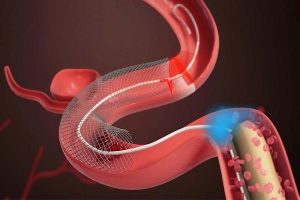
Every year, millions of people worldwide suffer from strokes. This medical condition is considered one of the leading causes of death and disability globally. Ischemic stroke, which is caused by the blockage of blood vessels supplying oxygen and nutrients to the brain, accounts for around 80% of all stroke cases. Timely treatment of ischemic stroke is crucial to reduce the damage to the brain and improve the chances of recovery. The development of Neurovascular Stent Retrievers has revolutionized the way ischemic stroke is treated, significantly improving patient outcomes.
What are Neurovascular Stent Retrievers?
Neurovascular stent retrievers are specialized medical devices used in the treatment of ischemic stroke. They are designed to remove blood clots from large blood vessels in the brain, restoring blood flow and preventing brain damage. These devices are essentially tiny mesh tubes made of metal, which are inserted into the blocked blood vessel via a catheter. Once inside, the stent retriever expands, attaching to the clot, and is then gently pulled out, removing the blockage.
How do they work?
The use of neurovascular stent retrievers in stroke treatment is based on the principle of mechanical thrombectomy. This procedure involves the physical removal of blood clots from the blocked blood vessels in the brain. Mechanical thrombectomy is considered the gold standard for the treatment of acute ischemic stroke caused by large vessel occlusion. This is because it can significantly improve patient outcomes compared to traditional treatment options, such as the use of thrombolytic drugs.
Neurovascular stent retrievers work by trapping the clot in their mesh-like structure, and as the device is pulled out, it removes the clot from the blood vessel. The procedure is minimally invasive and can be performed under local anesthesia. The use of neurovascular stent retrievers requires highly specialized skills and is usually performed by interventional neuroradiologists or neurosurgeons.
Get Your Sample Copy Here:: https://www.alliedmarketresearch.com/request-toc-and-sample/2737
Advantages of Neurovascular Stent Retrievers in Stroke Treatment
The use of neurovascular stent retrievers in stroke treatment has several advantages over traditional treatment options. These include:
Improved patient outcomes: Mechanical thrombectomy with neurovascular stent retrievers can significantly improve patient outcomes compared to traditional treatment options. Studies have shown that patients treated with mechanical thrombectomy have better functional outcomes and a lower risk of disability and mortality.
Faster treatment: Mechanical thrombectomy can be performed within hours of symptom onset, making it an effective treatment option for acute ischemic stroke. This is in contrast to thrombolytic drugs, which must be administered within a narrow time window of a few hours from symptom onset.
Minimally invasive: Mechanical thrombectomy with neurovascular stent retrievers is a minimally invasive procedure that can be performed under local anesthesia. This reduces the risk of complications and shortens hospital stays.
Cost-effective: Despite being a highly specialized procedure, mechanical thrombectomy with neurovascular stent retrievers has been shown to be cost-effective in the long term. This is due to the significant improvement in patient outcomes and reduced healthcare costs associated with stroke-related disabilities.
Challenges in the use of Neurovascular Stent Retrievers
While neurovascular stent retrievers have revolutionized the way ischemic stroke is treated, there are still some challenges associated with their use. These include:
Limited availability: The use of neurovascular stent retrievers requires highly specialized skills and equipment, making them less accessible in some regions of the world.
Time-sensitive: Mechanical thrombectomy with neurovascular stent retrievers is a time-sensitive procedure, and its effectiveness is greatly reduced after the first few hours of symptom onset. Therefore, timely diagnosis and referral to specialized stroke centers are crucial to ensure that patients receive the best possible treatment.
Risk of complications: Although mechanical thrombectomy is a minimally invasive procedure, there is still a risk of complications, such as bleeding and vessel perforation. The risk of complications is higher in patients with certain medical conditions, such as anticoagulant use, and requires careful patient selection.
Cost: While mechanical thrombectomy with neurovascular stent retrievers has been shown to be cost-effective in the long term, the upfront cost of the procedure and the equipment required can be a barrier to its widespread adoption, particularly in resource-limited settings.
Future Directions in the Use of Neurovascular Stent Retrievers
Despite the challenges associated with their use, neurovascular stent retrievers have revolutionized the way ischemic stroke is treated and have significantly improved patient outcomes. In recent years, there have been several advancements in the design and development of neurovascular stent retrievers, aimed at further improving their effectiveness and reducing the risk of complications.
One such advancement is the development of new materials for the stent retrievers, such as nitinol, a superelastic alloy that can withstand the forces of the procedure without breaking or deforming. Nitinol stent retrievers have been shown to be effective in removing clots and reducing the risk of complications.
Another area of research is the use of artificial intelligence (AI) and machine learning algorithms to improve patient selection and outcomes. AI algorithms can analyze patient data and imaging scans to identify patients who are most likely to benefit from mechanical thrombectomy with neurovascular stent retrievers, improving the accuracy of patient selection and reducing the risk of complications.
Neurovascular stent retrievers have revolutionized the way ischemic stroke is treated, significantly improving patient outcomes and reducing the risk of disability and mortality. The use of mechanical thrombectomy with neurovascular stent retrievers requires highly specialized skills and equipment and is a time-sensitive procedure. Despite the challenges associated with their use, there have been several advancements in the design and development of neurovascular stent retrievers, aimed at further improving their effectiveness and reducing the risk of complications. With continued research and development, neurovascular stent retrievers have the potential to further improve stroke treatment and reduce the burden of this devastating medical condition on individuals and society as a whole.
Contact Us:
David Correa
USA/Canada (Toll Free): +1-800-792-5285, +1-503-894-6022
help@alliedmarketresearch.com


